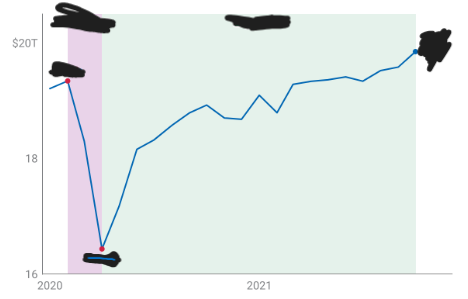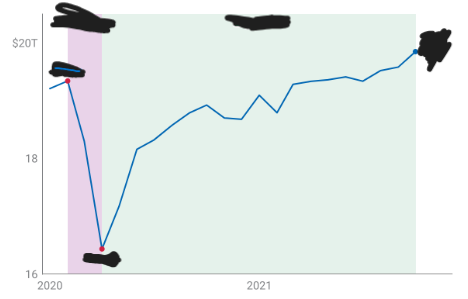Chapter 17: Tracking the Business Cycle
1/78
There's no tags or description
Looks like no tags are added yet.
Name | Mastery | Learn | Test | Matching | Spaced |
|---|
No study sessions yet.
79 Terms
the level of output that occurs when all resources are fully employed
potential output
What we can sustainable produce given our current resources
potential output
in the short run, the economy may fail to meet its
potential output
short-term fluctuations in economic activity
Business cycle
cause actual output to deviate from potential output
business cycle
the business cycle causes the (BLANK) to rise and fall sharply
unemployment rate
Even decades later, people who graduated in a recession tend to earn (BLANK) than those who graduated in better economic times
less
the difference between actual and potential output, measured as a percentage of potential output
output gap
output gap =
((actual output - potential output)/potential output) x 100
the economy is producing less than it can (called a bust)
negative output gap
idle resources: workers can’t find jobs, storefronts are shuttered, etc.
negative output gap
the economy is producing more than its potential (called a boom)
positive output gap
This unsustainable intensity is possible only for a short while
positive output gap

Trough

Peak

Recession

Expansion

Real GDP
a high point in economic activity
peak
a low point in economic activity
trough
a period of declining economic activity
recession
runs from peak to trough
recession
a period of increasing economic activity
expansion
runs from trough to peak
expansion
Keep going until they’re killed by an adverse shock
expansion
Recessions create a lot of
unhappiness
Are the economy’s fluctuations rhythmic, reliable, or predictable
no
recessions are
not inevitable
GDP measures the (BLANK) of output
level
GDP growth is about
changes
No two business cycles are ever the same, but they do have some common features: Recessions are
short and sharp
No two business cycles are ever the same, but they do have some common features: Business cycles are
persistent
No two business cycles are ever the same, but they do have some common features: Expansions are
long and gradual
No two business cycles are ever the same, but they do have some common features: business cycles impact (BLANK) parts of the economy
many
Rapid bounce-back following the coronavirus shutdowns
unusual expansion
The state of the economy this year is closely related to the conditions
next year
variables that move up and down together
comovement
If one part of the economy is doing well, then the other parts of the economy are probably doing
well
Creation of new businesses, housing construction, automobile sales, imports from
overseas, new investment projects, business profits, workers’ real wages, stock prices, inflation and interest rates
indicators that move together
industries that rise and fall together
goods-producing and private service-producing
industry that is usually more sensitive to the business cycle
goods-producing
variables that tend to predict the future path of the economy
leading indicators
tend to change first
leading indicators
business confidence, consumer confidence, the stock market
leading indicators
variables that tend to follow business cycle movements with a bit of a delay
lagging indicators
example of lagging indicator
unemployment
For every percentage point that actual output is less than potential output, the unemployment rate will be around half a percentage point higher
okun’s rule of thumb
If output gap declines from 0% to -4% then the unemployment rate will likely
rise by 2%
business cycles are not
cycles
data stripped of predictable seasonal patterns
seasonally adjusted
for easier comparison of date with different rates, use
annualized rates
data converted to the rate that would occur if the same rate had occurred throughout the year
annualized rates
data from a time period of less than a year converted into an annual rate
annualized rates
real variables are adjusted for
inflation
comparing quantities, holding prices constant
real data
chained 2012 dollars means
real data
makes it difficult to tell whether an increase reflects rising prices or rising quantities
nominal data
updates to earlier estimates are called
revisions
broadest measure of economic activity
real GDP
measures the total size of the economy
real GDP
What is the caution for real GDP?
incomplete when first released
acts as a useful cross-check on GDP
Real GDI
adds up total income
gross domestic income
GDP and GDI should be (BLANK), but often (BLANK)
equal, differ
early reports of (BLANK) are often more reliable than (BLANK)
GDI, GDP
tell you if the labor market is improving
nonfarm payrolls
tell you how many jobs are created each month by tracking the number of workers on businesses’ payrolls
nonfarm payrolls
indicator of excess capacity
unemployment rate
share of the labor force that wants a job but can’t find one
unemployment rate
how many people lost their jobs and applied for unemployment insurance during the previous week
initial unemployment claims
tells you want managers are planning
business confidence
tells you what consumers are thinking
consumer confidence
asks regular people how optimistic they are about the economy
consumer confidence
tells you what’s happening with prices
inflation rate
provides a sense of how much economy-wide prices are growing
consumer price index
tells you what’s happening with wages
employment cost index
how fast wages and benefits are rising
employment cost index
leading indicator of inflationary pressure
employment cost index
tells you about future expected profits of businesses
stock market